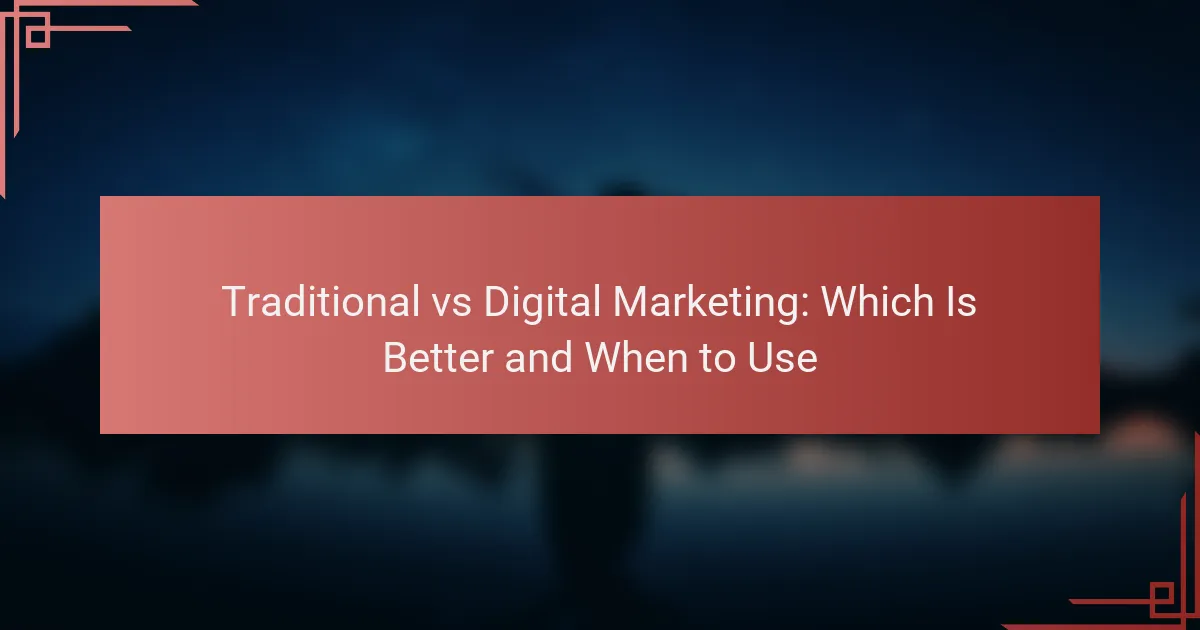In today’s competitive landscape, businesses must navigate the choice between traditional and digital marketing strategies to effectively reach their target audiences. While traditional marketing excels in building brand credibility and connecting with local demographics, digital marketing offers cost-effective solutions and global reach. Understanding when to leverage each approach can significantly enhance a brand’s overall marketing effectiveness.

What are the advantages of traditional marketing?
Traditional marketing offers several key advantages, including the ability to build brand credibility, effectively target local audiences, and utilize established methods that resonate with certain demographics. These benefits make traditional marketing a valuable strategy in specific contexts, particularly when reaching audiences that prefer conventional media.
Brand credibility and trust
Traditional marketing methods, such as print ads and television commercials, often convey a sense of legitimacy and trustworthiness. Consumers tend to view established brands that invest in physical advertising as more credible compared to those relying solely on digital channels. This perception can lead to stronger brand loyalty and customer retention.
For instance, a well-placed advertisement in a reputable magazine can enhance a brand’s image, making it appear more authoritative in its industry. Businesses should consider leveraging traditional marketing to reinforce their brand’s credibility, particularly in sectors like finance or healthcare where trust is paramount.
Targeting local audiences
Traditional marketing excels in reaching local audiences through targeted methods such as community newspapers, radio stations, and local events. These channels allow businesses to connect with potential customers in their immediate area, making it easier to drive foot traffic to physical locations.
For example, a local restaurant might benefit from advertising in a neighborhood newsletter or sponsoring a community event, effectively reaching residents who are more likely to visit. Businesses should focus on local marketing strategies to build a strong community presence and foster customer relationships.
Established methods and practices
Traditional marketing encompasses well-established methods that have been proven effective over time. Techniques such as direct mail, print advertising, and telemarketing have a long history of success and can be easily integrated into a marketing strategy.
Companies can utilize these methods alongside digital efforts to create a comprehensive marketing approach. For instance, a combination of direct mail campaigns and social media promotions can reinforce messaging and increase overall reach.
Higher engagement in certain demographics
Certain demographics, particularly older adults, may respond more positively to traditional marketing methods. Many individuals in these age groups are more accustomed to print media and television, making them more likely to engage with advertisements in these formats.
For example, a brand targeting seniors might find greater success with a television campaign than a digital-only approach. Understanding the preferences of target demographics is crucial for maximizing engagement and ensuring marketing efforts resonate effectively.

What are the advantages of digital marketing?
Digital marketing offers numerous advantages, including cost-effectiveness, real-time analytics, and the ability to reach a global audience. These benefits make it a powerful tool for businesses looking to enhance their marketing strategies.
Cost-effectiveness and ROI
Digital marketing is often more cost-effective than traditional marketing methods. Businesses can allocate smaller budgets to campaigns and still achieve significant returns on investment (ROI) through targeted online ads and social media promotions.
For instance, pay-per-click (PPC) advertising allows companies to only pay when users click on their ads, making it a budget-friendly option. In contrast, traditional media like print or TV often requires larger upfront costs without guaranteed results.
Real-time analytics and tracking
One of the key advantages of digital marketing is the ability to access real-time analytics and tracking. Marketers can monitor campaign performance instantly, allowing for quick adjustments to optimize results.
Tools like Google Analytics provide insights into user behavior, conversion rates, and engagement metrics. This data helps businesses make informed decisions and refine their strategies based on actual performance rather than assumptions.
Wider reach and global audience
Digital marketing enables businesses to reach a wider and more diverse audience than traditional methods. With the internet’s global nature, companies can connect with potential customers from different countries and cultures.
For example, social media platforms allow brands to engage with users worldwide, breaking geographical barriers. This expanded reach can lead to increased brand awareness and customer acquisition across various markets.
Targeted advertising capabilities
Digital marketing excels in targeted advertising, allowing businesses to tailor their messages to specific demographics and interests. This precision increases the likelihood of reaching potential customers who are more likely to convert.
Platforms like Facebook and Google Ads offer advanced targeting options based on user behavior, location, and interests. This capability ensures that marketing efforts are directed towards the right audience, maximizing effectiveness and minimizing waste.

When should businesses use traditional marketing?
Businesses should consider traditional marketing when they aim to reach specific local audiences or demographics that may not engage with digital platforms. This approach is particularly effective for building brand recognition and trust in communities through tangible, physical interactions.
For local events and promotions
Traditional marketing excels in promoting local events and promotions, as it allows businesses to connect directly with their community. Tactics such as flyers, posters, and local newspaper ads can effectively inform residents about upcoming events, sales, or special offers.
For instance, a local restaurant might distribute flyers in nearby neighborhoods to announce a food festival, ensuring that the message reaches potential customers who may not be active online. Consider using community bulletin boards or sponsoring local events to increase visibility.
When targeting older demographics
Older demographics often respond better to traditional marketing methods, as they may be less familiar with digital channels. Television, radio, and print media can be more effective for reaching this audience, who may prefer these formats for information consumption.
For example, a retirement community could use local newspapers and radio stations to advertise their services, ensuring they reach seniors who may not use social media. Tailoring messages to resonate with this age group is crucial for successful engagement.
For building long-term brand loyalty
Traditional marketing is effective for fostering long-term brand loyalty through consistent, memorable messaging. Tactile materials like brochures or branded merchandise can create a lasting impression that digital ads often lack.
For instance, a company might send out personalized thank-you cards to customers after a purchase, reinforcing a positive relationship. Regularly participating in community events can also help solidify brand presence and loyalty among local consumers.

When should businesses use digital marketing?
Businesses should use digital marketing when they aim to reach a broad audience quickly and effectively. This approach is particularly beneficial for campaigns that require real-time interaction and measurable results.
For online product launches
Digital marketing is essential for online product launches as it allows businesses to create buzz and reach potential customers instantly. Utilizing social media, email campaigns, and targeted ads can generate excitement and drive traffic to the product page.
Consider using platforms like Facebook and Instagram for visual promotions, or Google Ads for search visibility. These channels can help you reach a larger audience within days, rather than weeks or months.
When targeting younger audiences
Digital marketing is particularly effective for targeting younger audiences, who predominantly engage with brands online. Platforms like TikTok, Snapchat, and Instagram are popular among this demographic, making them ideal for campaigns aimed at younger consumers.
To connect with this group, focus on creating engaging content that resonates with their interests and values. Authenticity and creativity are key, as younger audiences tend to favor brands that reflect their lifestyle and beliefs.
For immediate feedback and engagement
Digital marketing offers the advantage of immediate feedback and engagement, allowing businesses to adjust their strategies in real-time. Tools like social media polls, comments, and analytics can provide insights into customer preferences and behaviors.
Encourage interaction by asking questions or running contests on social media. This not only boosts engagement but also helps you gather valuable data to refine your marketing efforts quickly.

How do traditional and digital marketing compare in cost?
Traditional marketing often incurs higher upfront costs compared to digital marketing, which typically offers more budget-friendly options. Businesses should consider their target audience and marketing goals when deciding which approach to invest in.
Traditional Marketing Costs
Traditional marketing includes expenses related to print ads, television commercials, radio spots, and billboards. These costs can range from hundreds to thousands of dollars, depending on the medium and reach. For instance, a full-page ad in a national magazine may cost several thousand USD, while local newspapers might charge a few hundred.
Additionally, traditional marketing often requires longer lead times and may involve ongoing costs for maintaining campaigns. Businesses should factor in production costs, distribution fees, and potential agency commissions when budgeting.
Digital Marketing Costs
Digital marketing generally offers more flexible pricing structures, allowing businesses to choose from pay-per-click (PPC), social media ads, email campaigns, and content marketing. Costs can vary widely; for example, PPC campaigns can start as low as a few cents per click, while social media ads may require a minimum daily budget of around 5-10 USD.
Moreover, digital marketing allows for real-time tracking and adjustments, enabling businesses to optimize their spending based on performance. This can lead to more efficient use of marketing budgets, especially for small to medium-sized enterprises.
Cost-Effectiveness Comparison
When comparing cost-effectiveness, digital marketing often provides a higher return on investment (ROI) due to its ability to target specific audiences and measure results accurately. For example, a well-targeted email campaign can yield a significantly higher ROI compared to a broad-based print ad.
However, traditional marketing can still be effective for brand awareness in specific demographics or local markets. Businesses should assess their audience’s preferences and behaviors to determine the most cost-effective strategy for their goals.



